Life-cycle assessments
Environmental performance in black and white
How environmentally friendly are forklift trucks, lift trucks, etc.? Customers of Linde Material Handling who want to assess and optimise their own environmental performance are now able to obtain robust data for this endeavour. The Company joined forces with the Fraunhofer Institute for Building Physics (IBP) to carry out a sophisticated process and develop a life-cycle assessment methodology. This has now been certificated by the TÜV Rheinland technical inspectorate.
From cradle to grave
Linde Material Handling has been committed to improvement of performance and environmental efficiency in its products for many years now. The entire life-cycle of important product series has now been analysed in great detail in order to draw further conclusions about potential measures benefiting the environment and provide customers with evidence-based options for decision-making. The analysis has covered all stages in the life-cycle of the main product series, from the sourcing of raw materials, through production of each component, usage by customers to “end-of-life” of the product, including transport pathways and spare-parts service – truly from cradle to grave.
The methodology and the resulting life-cycle assessments for seven product clusters were tested and certified by the TÜV Rheinland technical inspectorate. This is because the process is not going to end with the areas that have already been investigated. In future, Linde will be able to use its own dedicated, externally methodology to analyse product sub-groups or new models on its own.
In the first stage, counterweight trucks powered by internal combustion engines (IC trucks), electric counterweight trucks, reach trucks, pallet trucks, pallet stackers, order pickers and tow tractors were analysed. A reference model was identified from each of these product groups and a detailed assessment was carried out. This was generally the vehicle with the highest sales volume in Europe.
Transparent methodology
The life-cycle assessment methodology is based on the requirements of the ISO standards 14040 and 14044. These standards guarantee a uniform approach and the necessary transparency for assessing the resulting environmental impacts. The GaBi software being used is established worldwide as the specialist software and material database for life-cycle assessments.
The assessment is carried out in four hierarchical stages: the definition of the target and the analysis framework, the generation of the life-cycle inventory, the impact assessment and the interpretation of the results. All incoming and outgoing material and energy flows are included in the life-cycle inventory and the emissions generated over the entire process chain are recorded. In the impact assessment, all the emissions generated over the life-cycle are then assigned to the observed environmental impacts (classification) and presented in the corresponding impact categories on the basis of their contributions, e.g. global warming potential (characterisation).
The results of the analyses provide the platform for integrating environmental aspects into the development process of future products and strategically improving their environmental characteristics. The approach of the life-cycle ensures that optimisation of individual system modules cannot exert a negative impact on the overall life-cycle assessment.
The results in detail
The following charts show five selected impact categories which are in the area of greatest impact and are most easily verified by analysts. Beyond the individual product groups, the results demonstrate that the usage phase with the customer exerts the greatest impact on the environment. It has also emerged that the manufacture of the battery system plays a significant role with electrically powered trucks.
Furthermore, the manufacture of an industrial truck exerts almost the same impact on the environment as maintenance. Conversely, transport and service journeys only have a minimal impact. During the recovery phase at the end of the utilisation phase, environmental “credits” are generated by recycling, mainly from the metals and also from the battery in the case of electric vehicles.
Electric and IC trucks on average respectively account for 85% and more than 90% of the environmental impacts during the usage phase. Conversely, only very low values are incurred in the other life-cycle phases. The potential for optimisation is therefore with IC trucks, most particularly in relation to the reduction of fuel consumption and the associated decrease in exhaust emissions.
The top drivers in electric and reach trucks, and pallet stackers are electricity consumption, losses in the battery system, battery charging losses and the vehicle body. Consistent recycling in electric trucks is able to compensate for up to 50% of the environmental impacts in the production phase.
The environmental impacts in low-lift order pickers and pallet trucks, and tow tractors are essentially distributed in the manufacture and usage phase. Depending on the impact categories for the manufacturing phase, the value varies between 10% and 32%. The value does not fall below 40% with any vehicle type during the usage phase. The higher value in the manufacturing phase for tow tractors, low-lift order pickers and pallet trucks is determined by the size of the vehicle. They are significantly smaller and lighter, and this also reduces the energy consumption compared with the counterweight trucks.
Because the usage phase is highly relevant for environmental impacts, the measures for electric vehicles concentrate on improving the level of battery efficiency and extending the life-circle of the batteries.

Diesel and LPG-powered trucks
Top three drivers
- Forklift truck operation
- Diesel production
- Vehicle body
Life-cycle impacts (in %)
Enlarge image
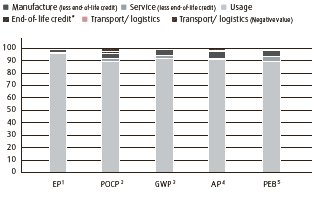

Electric trucks
Top three drivers
- Electricity consumption per vehicle
- Losses for battery systems
- Losses for charging unit
Life-cycle impacts (in %)
Enlarge image
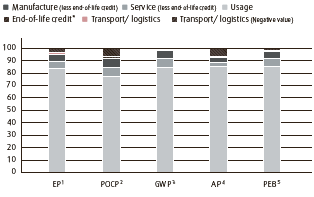

Tow trucks
Top three drivers
- Electricity consumption per vehicle
- Losses for the battery system
- Vehicle body
Life-cycle impacts (in %)
Enlarge image
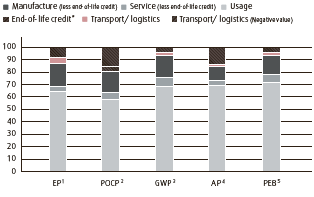

Pallet trucks
Top three drivers
- Electricity consumption per vehicle
- Losses for the battery system
- Load lift system
Life-cycle impacts (in %)
Enlarge image
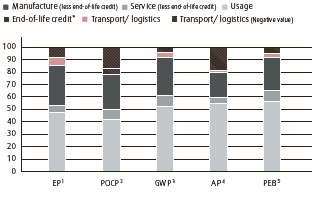
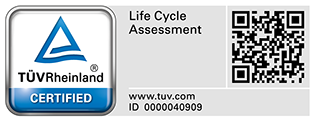
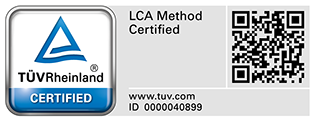
1 EP: Eutrophication potential (kg phosphate equiv.)
2 POCP: Photochemical oxidant potential (kg ethylene equiv.)
3 GWP: greenhouse gas potential (kg CO2 equiv.)
4 AP: acidification potential (kg SO2 equiv.)
5 PEB: Primary energy requirement from non-renewable resources (MJ)
* Reduction of environmental impacts by product recycling. Truck transport results in negative values as a result of nitrogen monoxide emissions from exhaust gases. Nitrogen monoxide has the capability to form ozone near the ground and exceeds the other emissions in this presentation.
